CW90 May, 2024
Some financial indices of Chigasaki and neighboring municipalities

The Ministry of Internal Affairs and Communications released, in March, its latest statistics on financial indices of the nation’s 1,741 municipalities. Some indices of Chigasaki and its neighboring municipalities are in the table below. Figures are the average of the three years from 2020 to 2022.
For each index, the left sub-column (ivory column) shows actual values, and the right blue one shows ranks among Kanagawa prefecture’s 33 municipalities. The financial capability index, the leftmost column, is a measure of a municipality’s wealth. The larger the index, the better the municipality’s financial situation. An index smaller than 1.0 shows the municipality received tax subsidies from the government.
In Kanagawa, there are seven municipalities with an index larger than 1.0, indicating that their tax revenue exceeded their expenditure, or in other words, they are financially healthy. The three other indices indicate the flexibility of current finance, the financial strain of local bonds, and limitations of future finance. (Source) Statistics on financial indices of the nation's municipalities
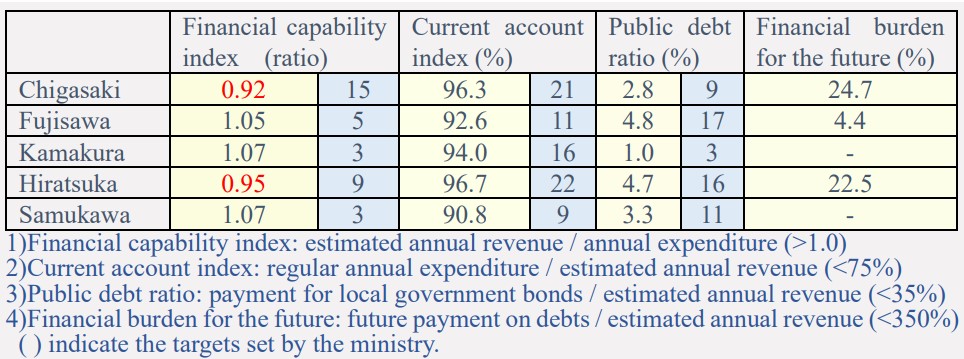
Chigasaki had worked on improving its finance based on the plan set in March 2020. The results were reported in August 2023. Go to
Report in August 2023
The report says the city started getting rid of waste in each section, without setting up a big project over the whole organization, and their effort produced some positive results. The figures for Chigasaki in the table reflect the results.
Southern Beach opens for swimming on July 6 (Sat)
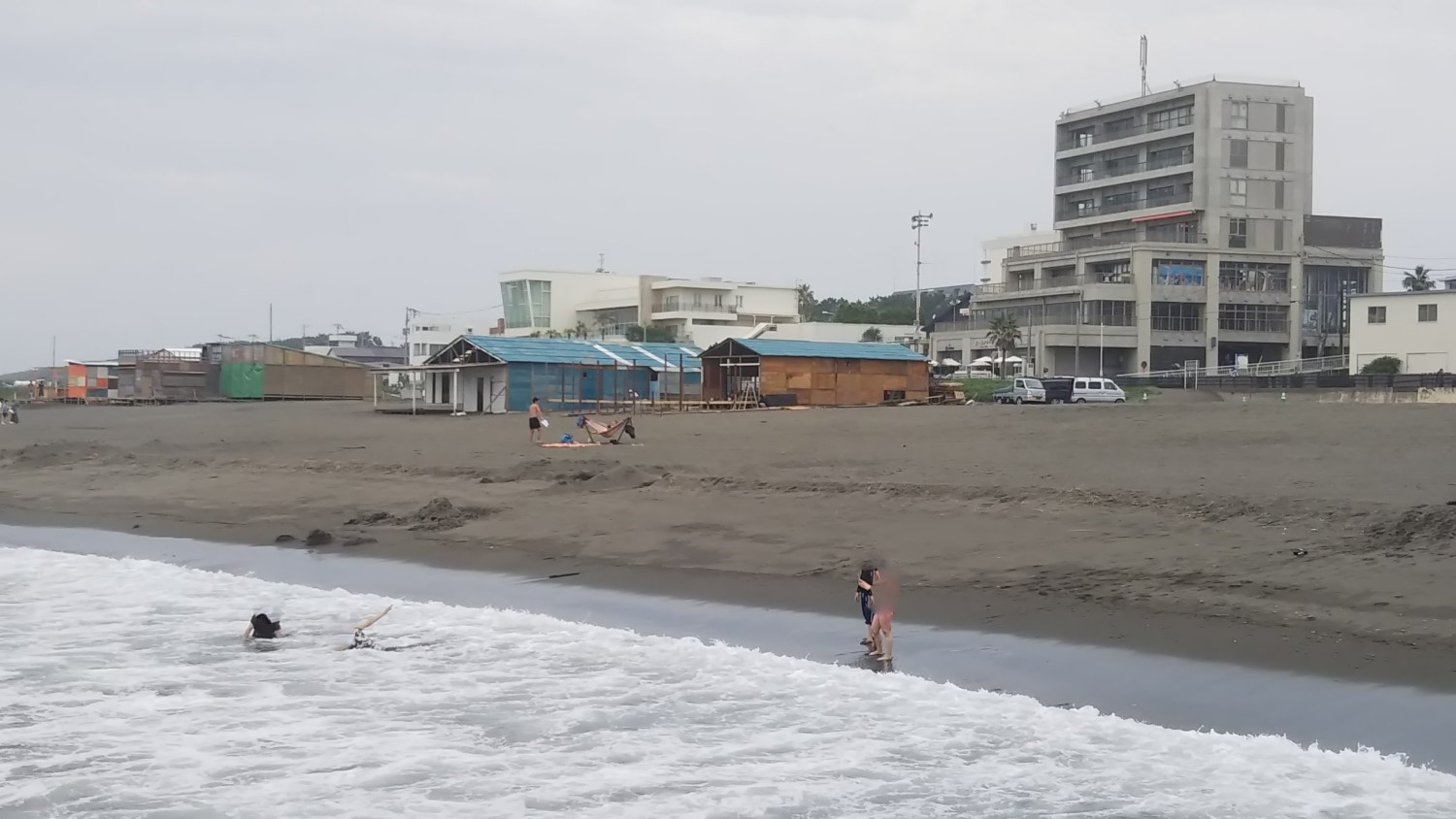
We have fine and rainy days alternately here in Chigasaki, but in Okinawa the rainy season has already set in. Southern Beach Chigasaki is going to open from July 6 (Sat) to September 1 (Sun). Same as last year, barrier-free mats will be spread to the seashore for wheelchair and buggy users. In addition, the parking area will have easier access to the beach this year.
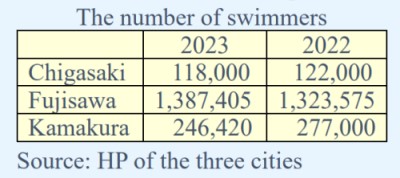
The table on the right is a comparison of the numbers of swimmers in three cities. Fujisawa attracted far more visitors than the others. Chigasaki beach, as a small but quality beach, can provide a good service and safe bathing place.
The Meteorological Agency has forecasted that July will be hotter than average in eastern Japan and August will be very hot across the nation. The swimming season is just around the corner.
Flowers of the season Giant flowered magnolia
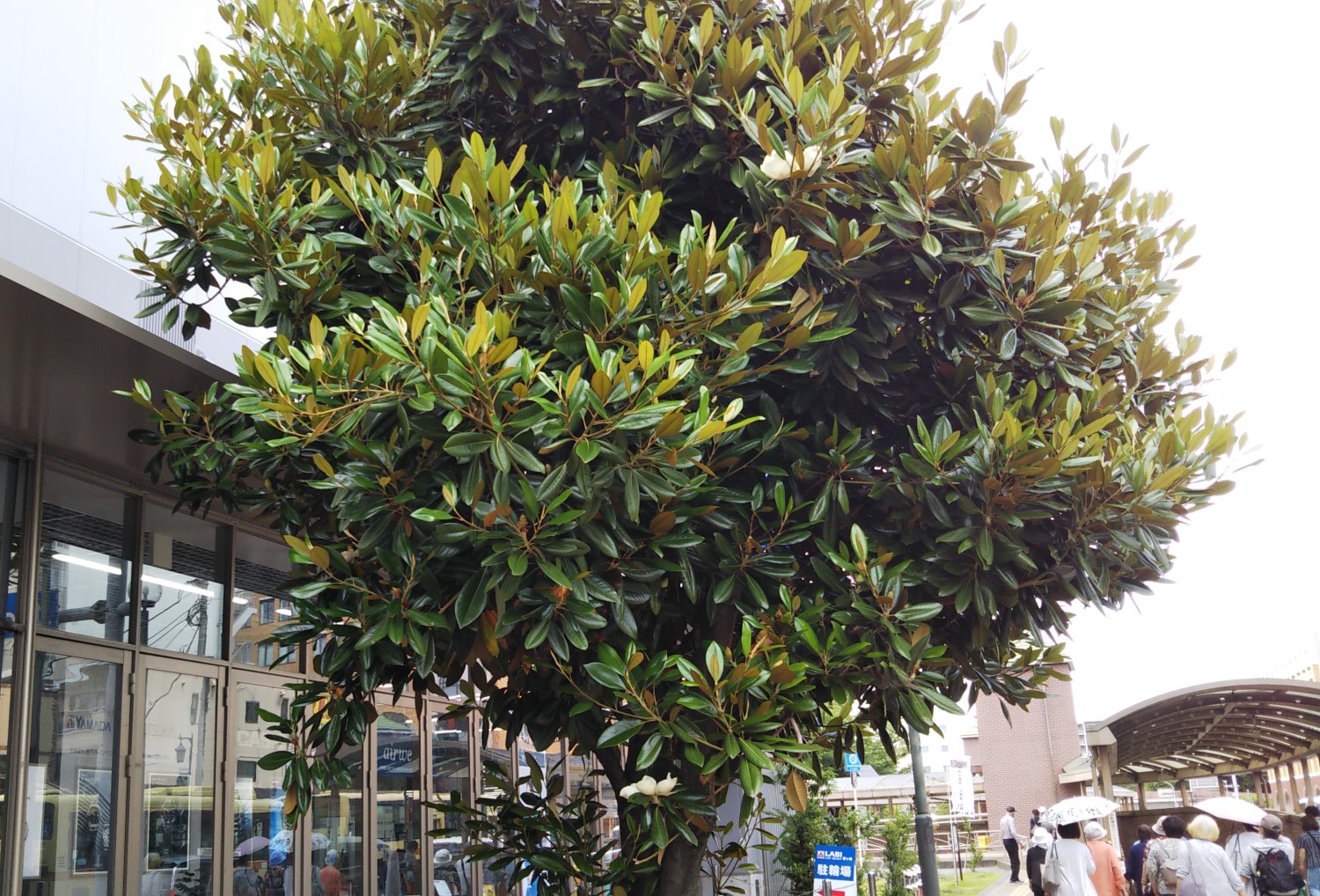
There are two big giant flowered magnolias near the Chigasaki Station’s north exit. After getting out the north exit, walk northward along the left sidewalk of the bus route, and you must feel the strong fragrance under the trees in front of the home appliance store, Yamada Denki. The blossoms, 15 to 30 centimeters in diameter, with nine white petals shaping a bowl, bloom upward at the end of branches from May to July. A blossom lasts about three days. They emit a pleasing smell containing β-ocimene, geraniol and other compounds. The evergreen trees grow up to 20 meters plus in height. The highest-ever tree on record is 37.2 meters tall. The leaves are alternate. They are 13 to 26 centimeters long and 4.5 to 12.5 centimeters wide with their rims rolling back. Upper sides of the fleshy and leatherlike leaves are shiny green, and their lower sides are filled with brown fuzz. Old leaves turn brownish yellow from spring to early summer before falling.
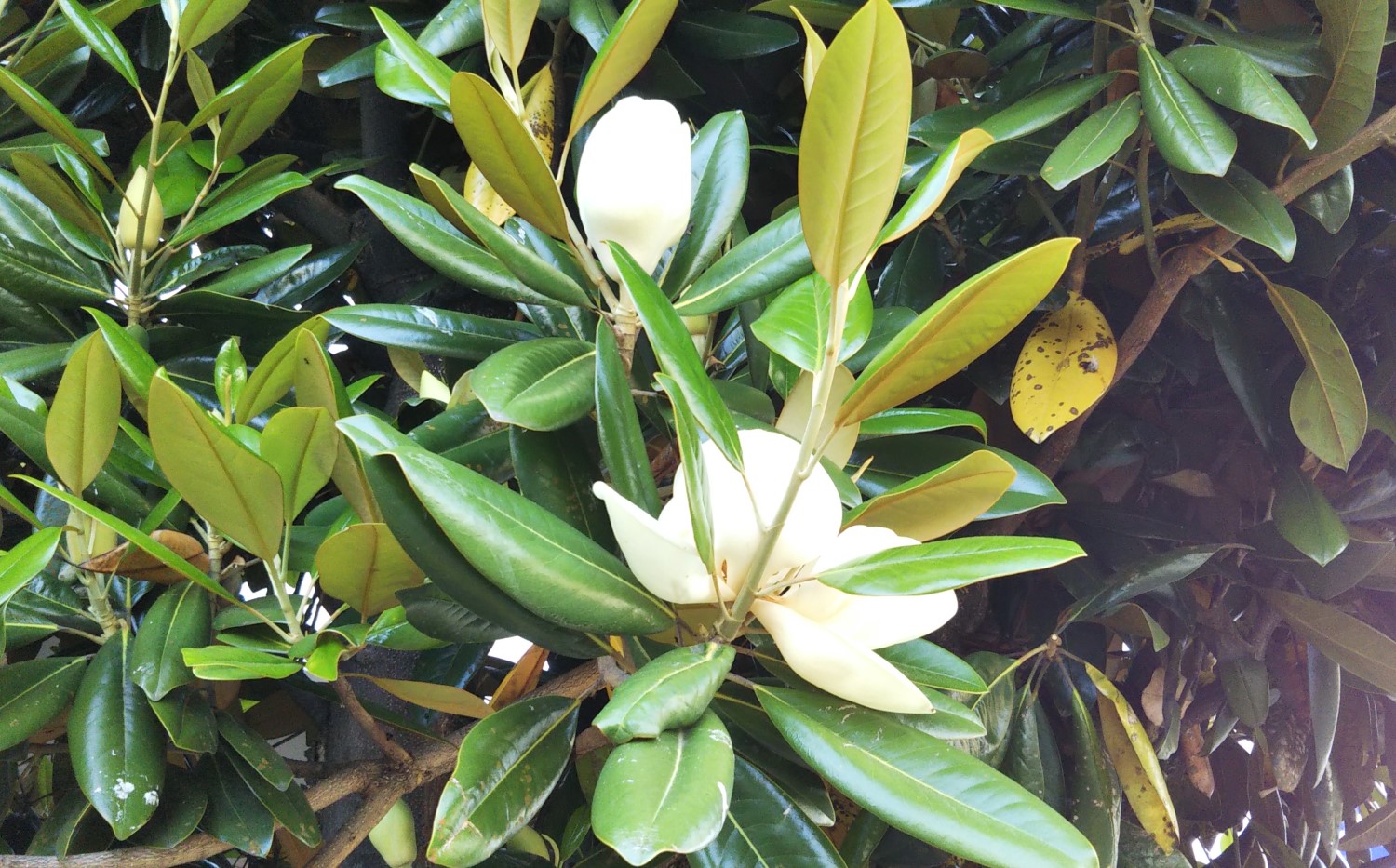
Giant flowered magnolia native to North America was introduced into Japan in 1868, the first year of the Meiji era, and was planted in parks and gardens in Tohoku and further south. The plant prefers fertile, well-drained soil and a sunny or half sunny place. The trees are known for having strong allelopathic effects, and there is almost no vegetation under the trees. About 150 varieties were created, and 30 to 40 of them persist today. In two southeastern states of the US, Mississippi and Louisiana, giant flowered magnolia is designated as the states’ tree, and residents have got familiar with its big white blossoms as the emblem of each state’s flag.
History of Chigasaki: Tsutsumi Village (2)
Other monuments of the Satsuma Rebellion are in the precincts of Hachioji Shrine in Hishinuma and Mishima Shrine in Hagisono. The former tells that Ryuzo Shimazaki fell in battle, and the latter that Shogoro Kato died of a disease at 25 on his way home after the war.
The word 地頭, or Jito in 新編相模国風土記稿 (the new edition of Sagami province topography) means the leader of Tsutsumi Village. The village was reigned over by the Ooka Family throughout the Edo period.
Hideyoshi Toyotomi overthrew the Hojo family of Odawara in 1590, and appointed Ieyasu Tokugawa as the lord of six territories in the Kanto area, including Izu. In August, Ieyasu moved into the Edo castle. He established two groups of villages: one was directly ruled by the Tokugawa family and the other by his vassals. Villages in the Edo era were born in this way.
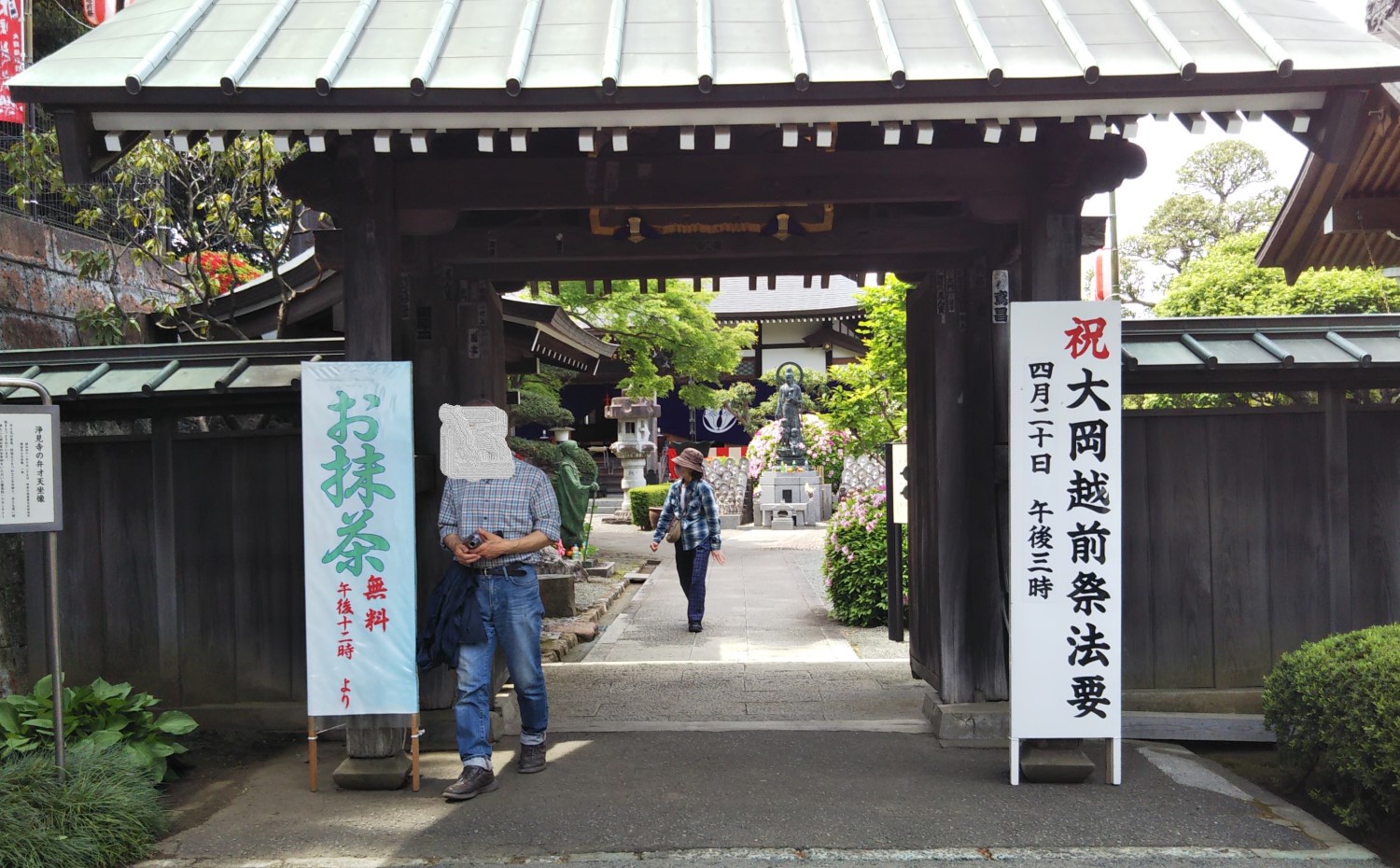
In May 1591, Ieyasu gave Tsutsumi Village to Tadamasa Ooka, who had been one of his vassals since Ieyasu was still in Mikawa, today’s Aichi prefecture. Tadamasa seemed to settle in the village just after he came to Kanto. 風土記稿 describes that there was the former encampment of the Ooka family to the southeast of Jyokenji Temple. He lived there first, and then moved to Edo. However, where and when he lived is not certain.
The family tree of Tadamasa shows he built Sogetsusan Jyokenji Temple in the village as his family temple in 1611, and in 1615, he moved the remains of his father, Tadakatsu, to the temple from Mikawa. However, the reburial was conducted by Tadamasa’s son, Tadayo, according to 風土記稿. Its honorific mountain prefix is Sogetsu-san, and its temple name is Jyoken. The prefix and temple name are the posthumous name of Tadakatsu, that is, 窓月浄見 (Sogetsu-jyoken).

Tadakatsu donated the statue of Amitabha Tathagata to the temple as the main image the year after he constructed it. In the graveyard, there are gravestones of Tadakatsu, Tadamasa, and other Ooka family members. They are designated as the city’s historic site.
Interested in Japanese proverbs?
1) 京の夢大阪の夢 (KYO NO YUME OSAKA NO YUME)
KYO means Kyoto city, NO about, YUME a dream, OSAKA Osaka city, NO YUME.
The proverb is interpreted in several ways.
One is: in dreams, people can go anywhere at any time. A person in Kyoto may have a dream that they are sightseeing in Osaka, and the other way around.
Another explanation is: dreams make it possible for people to realize whatever they want to accomplish.
The other explanation is: different people have different dreams. Some want to become rich, and some want to become a great politician.
Today, this saying is recited with friends before they tell each other the dreams they had the night before.
The saying is in 諺苑, or Gen-ene, which is a Japanese dictionary of the Edo era. The collection of ordinary people’s spoken words and proverbs was completed in 1797. Its English equivalents are:
●Hope is grief’s best music.
●Hope is the poor man’s bread.
●Hope springs eternal in the human breast.
2) 憎まれっ子世に憚る (NIKUMAREKKO YO NI HABAKARU)
NIKUMAREKKO means a naughty child, YO society, NI in, and HABAKARU to have one’s own way.
The proverb says a naughty child goes on to have a powerful influence, and succeed in society. Such a child lives a strong life and learns the secrets to getting people to cooperate while he or she is young.
Looking up the lives of great people on the internet, however, a quite limited number of those who embodied the proverb were found. They are, for example, Napoleon Bonaparte, John F. Kennedy, Babe Ruth, Mokichi Saito, and Taisuke Itagaki.
It seems to be more the case that curious children with a quiet personality become influential people, if they are left in peace.
The proverb is in 好色万金丹 (Koshoku-mankintan) published in 1694, a popular erotic book for townspeople in Osaka. Koshoku means lecherous, and Mankintan an antidote. Its English equivalents are:
●A bad thing never dies.
●Fortune favors the bold.
●The weeds grow apace.
Short Essays on Chigasaki-12 Tokichi Yamamiya & Satonosuke Ito, and the opening of Chigasaki Station (Modern times)
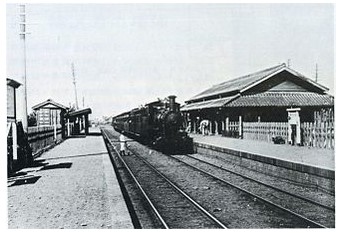
Japan’s first railway, connecting Shimbashi (currently Shiodome) and Yokohama (currently Sakuragi-cho), started its operation in September 1872. A steam locomotive left Shimbashi Station with a loud whistle. Also, the Tokaido line between Yokohama and Kozu opened in 1887, with stations built on the sites of former post stations(宿場)in Fujisawa, Hiratsuka and Oiso. (Photo the upper right: Chigasaki Station around 1898 from Japan National Railway photos )
Residents of Chigasaki received less benefits from the opening of the Tokaido line, which sparked a civic movement to open a station in Chigasaki. Finally, Chigasaki Station opened on June 15, 1898. The following are memos written in February 1895 in the diary of Tokichi Yamamine, the then Tsurumine village master.
February 8
A volunteer coalition meeting was held at Saiunji Temple(西運寺).
February 9
A committee met in the Chigasaki Village Hall.
February 10
Satonosuke Ito (the Chigasaki village master) and Yamamine drafted a petition for building a station in Chigasaki.
February 13
They visited the government office in Tokyo with the petition. It said, “We came here to ask for the building of Chigasaki Station. The distance between Fujisawa and Hiratsuka Stations is 13km, so it’s very inconvenient for Chigasaki citizens to use the Tokaido line. We are ready to donate the land for the station.”
Opening of Chigasaki Station has contributed to a rapid modernization of Chigasaki.
(The source of the essay: Chigasaki People’s Book published by Chigasaki City)
Events in May and June
Picture exhibition by Group Sai
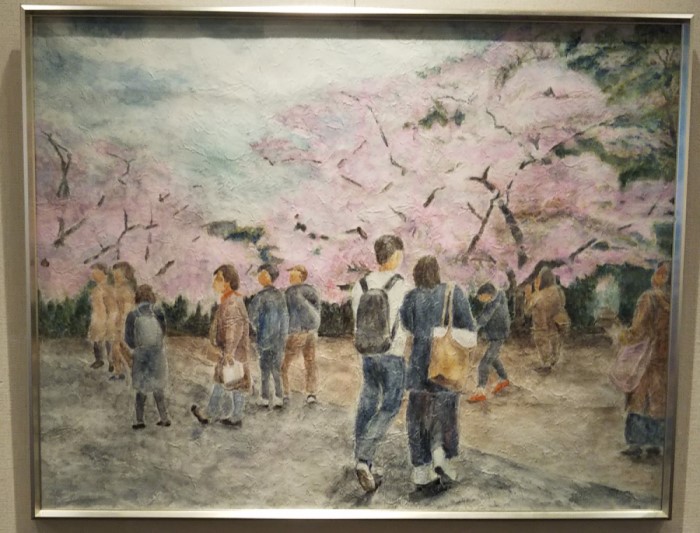
Two pictures by their tutor and 35 by 12 club members were exhibited from May 21 (Tue) to the 26th (Sun) at Citizen Gallery on the 4th floor of N’EST-CE PAS Chigasaki. Group Sai holds their exhibition once a year, and this was their 35th exhibition. In addition to gathering at Kowada Community Center for drawing on Fridays, they go sketching. They say new members are welcome.
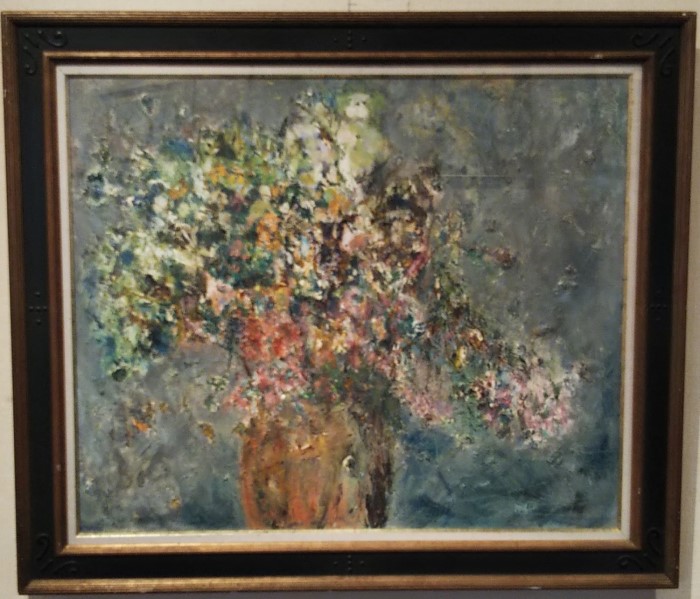
Exploring Color and Space by Shingo Francis
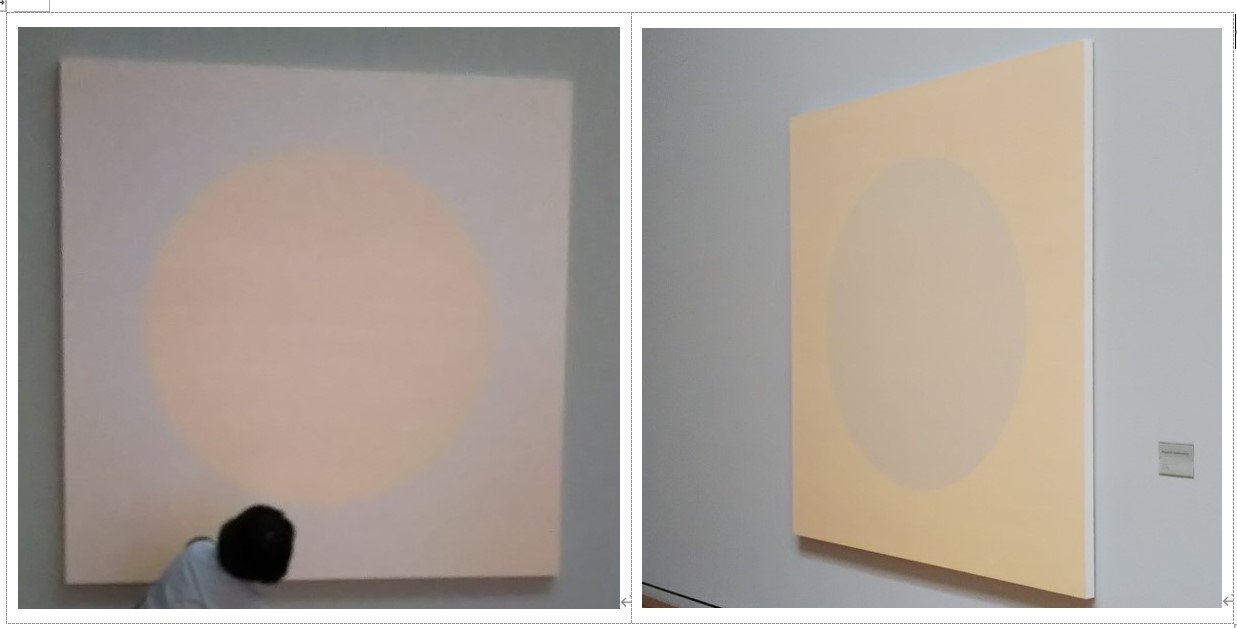
A solo exhibition of modern art took place in Chigasaki City Museum of Art from March 30 (Sat) to June 9 (Sun). Most works looked to have been painted in a single color, but they changed their colors according to the angle of incidence, and visitors’ positions. The two photos above are of the same work, and the reporter looked at it from squarely in front (left) and from diagonally right (right). Many visitors sat on the bench sofa, gazing at pictures from various angles. A group of similar pictures are entitled Interference.
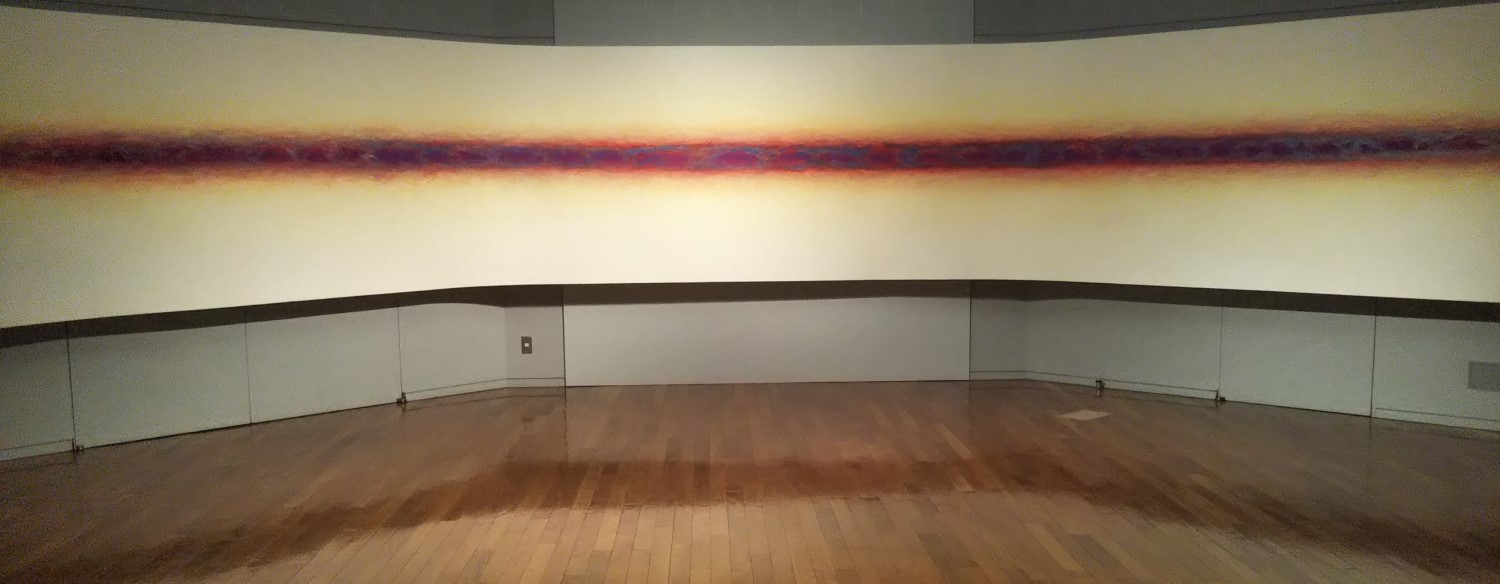
The photo above is entitled Bound for Eternity. The 152cm x 1,800cm painting occupied a few walls of an exhibition room. The curved long picture means infinite expanse of space and time, and a brown strip means things we experienced and are experiencing now. The painting belongs to the type of Installation, which is a category of modern art. Various objects are placed in space, and the space is considered to be a work. Francis works in his studios in Los Angeles and Kamakura these days.
Oto-Sada Oppeke Festival

Oto-Sada Oppeke Festival was held on June 1 (Sat) and 2 (Sun) sponsored by Chigasaki City. The festival named after Otojiro Kawakami and his wife, Sadayakko, had a wide range of cultural events, including a students’ calligraphy exhibition, harp concerts, a local music festival, picture-story shows, tea ceremony performances, a Haiku display and a theatrical performance, ‘Madame Butterfly’ in Takasuna-ryokuchi, next to the city library. The title role was played by a female member of the municipal assembly, and supporting roles were by professional actors.
Otojiro and Sadayakko used to live in Takasuna-ryokuchi in the late Meiji era. Talking of Otojiro, many Japanese remember ‘Oppekepe-bushi,’ which he chanted on stage to the rhythm of percussion performances like today’s lap musicians, during the intermission between two dramas, calling for democratic rights. They toured the US and Europe, and Sadayakko’s Japanese dance ‘Dojoji’ extremely attracted European artists at the Paris World Exposition in 1900. In Takasuna-ryokuti, a water well they used still remains.
Events in June and July
Citizen Gallery and Civic Hall (Admission free)
Citizen Gallery and Civic Hall (Admission free)
Citizen Gallery on the 4th floor of N’EST-CE PAS Chigasaki (Admission free)
● Art exhibition by “A”: May 30 (Thu) 13:00~18:00, the 31st (Fri) to June 1 (Sat) 11:00~18:00, the 2nd (Sun) 11:00~17:00
● The 24th calligraphy exhibition by Chigasaki Calligraphic Association: June 27 (Thu) 13:00~18:00, the 28th (Fri) and 29th (Sat) 10:00~18:00, the 30th (Sun) 10:00~17:00
● Calligraphy exhibition by Cheerful company of Senkei Shoin: July 12 (Fri) 13:00~17:00, the 13th (Sat) 10:00~17:00, the 14th (Sun) 10:00~16:00
Civic Hall (Admission free)
● Bonsai exhibition by Chigasaki Bonsai Friendship Club: June 7 (Fri) 13:00~17:00, the 8th (Sat) 9:00~17:00, the 9th (Sun) 9:00~16:00
Muse In Art Nouveau by Alfons Mucha at Chigasaki City Museum of Art
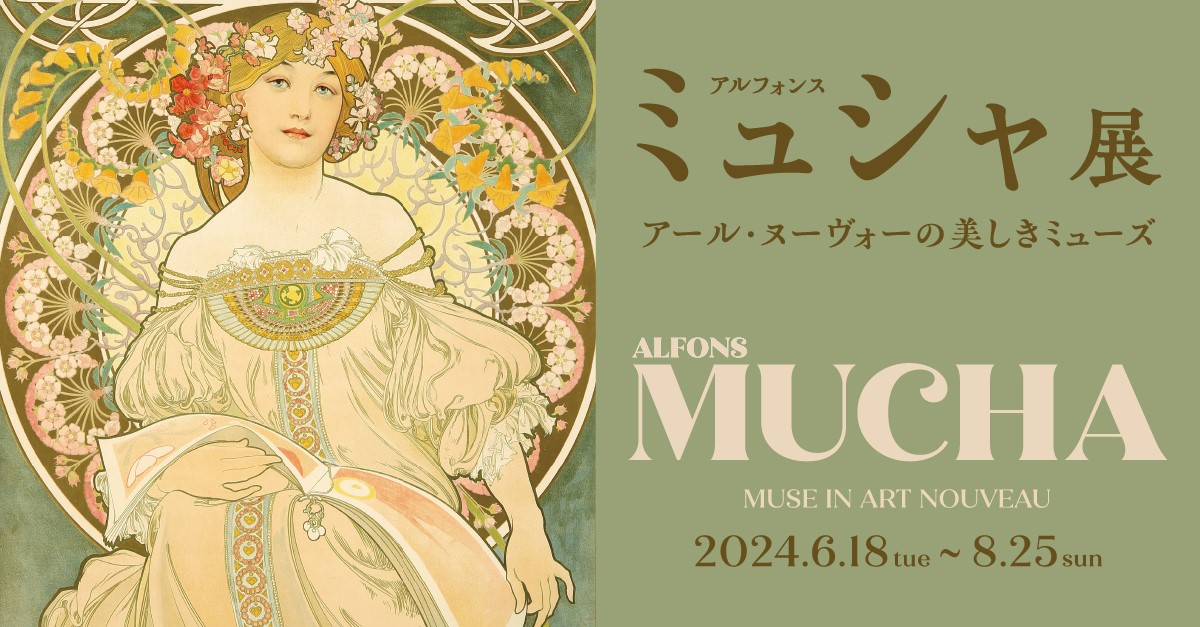
Alfons Mucha, 1860-1939, was a Czech artist who represented Art Nouveau, a painting style that flourished in late 19th-century Europe. Graceful women with patterns of trees and grasses in the background have since fascinated many people. On display will be his posters, panels, post cards, and postage stamps.
Date: June 18 (Tue) to August 25 (Sun)
Entrance fee (yen): Adult 1,200, Uni. student 1,000, Citizen aged 65 and over, High school Student and younger, and disabled person and their carer free
Opening of Southern Beach Chigasaki
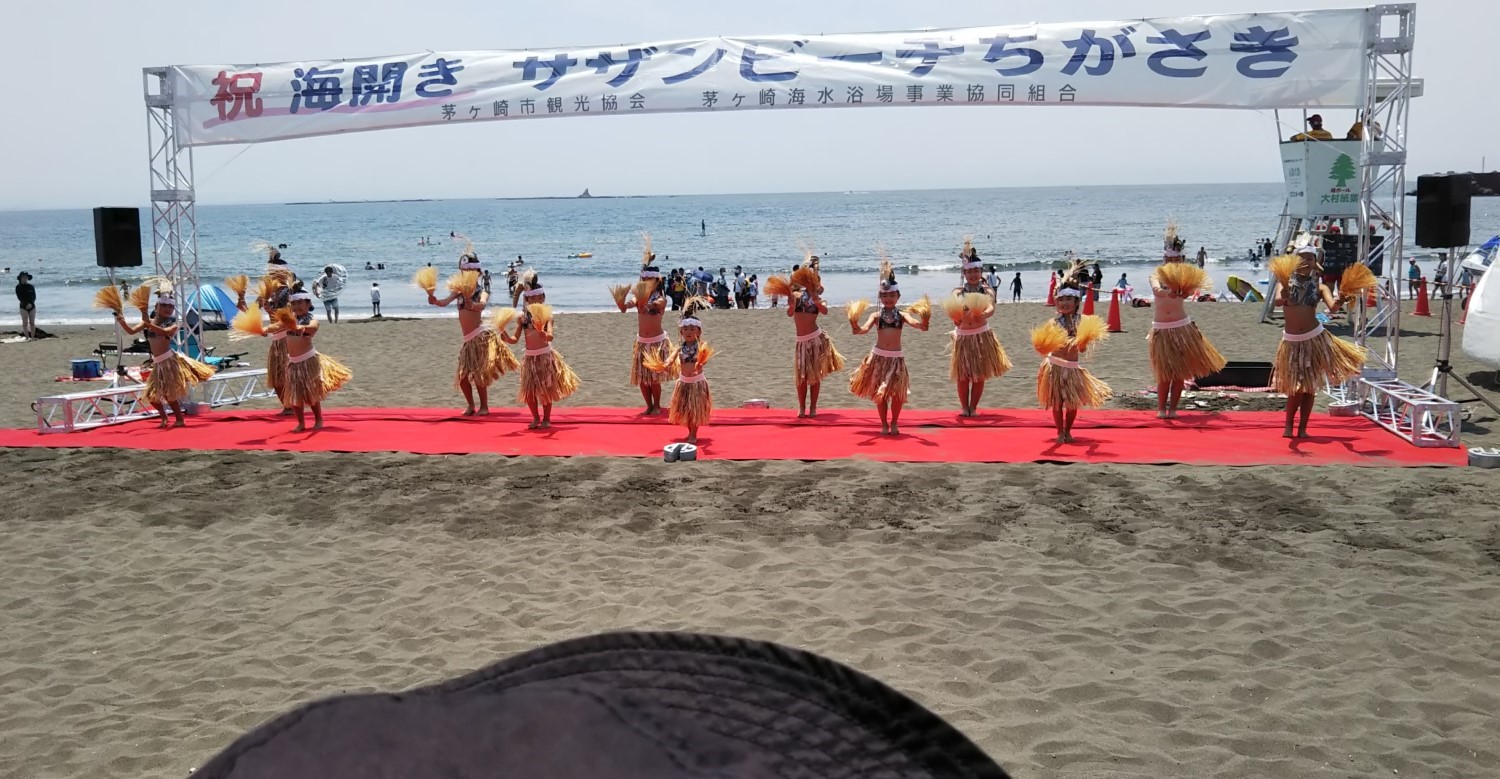

Southern Beach Chigasaki is going to open from July 6 (Sat) to September 1 (Sun). The beach has become barrier-free and more accessible from parking lots. May every visitor enjoy and have a good time.
The opening ceremony: July 6 (Sat) at 10:00
● A prayer for safety, ribbon-cutting ceremony, and hula dancing.